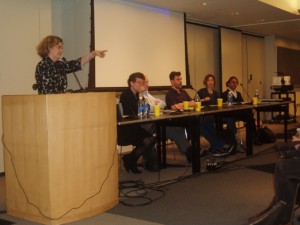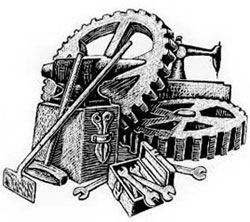Public History in New York City Event at Gotham Center
As someone with a strong interest in both New York City history and in the ways in which history is made accessible to and interpreted by the broader public, I was eager to attend the panel discussion on “Public History in New York City’s Cultural Life†held at the Graduate Center on Monday, April 6th. Co-sponsored by ASHP/CML and the Gotham Center for New York City History, the event was held in memory of Adina Back, an historian, educator, and colleague whom many at the ASHP knew personally. I was not disappointed; the evening’s five panelists represented an array of backgrounds, ranging from more traditional academics to oral historians to artists (and one artist/fire fighter), and an equally diverse assortment of approaches to public history. I was particularly struck by the innovative ways in which panelists engaged with local communities to shape and inform their various projects. Oneka LaBennett, research director for the Bronx African-American History Project, described the way her project works in conjunction with students and academics at Fordham University to reach out to members of the community in order to benefit from their individual memories as well as from their direct participation. Similarly, Deborah F. Schwartz, President of the Brooklyn Historical Society, discussed her institution’s efforts to enlist the efforts of Vietnam veterans and members of a Carroll Gardens parish in shaping the Society’s exhibitions. Ruth Sergel, an artist and filmmaker, described how her engagement with the city’s history arose out of her desire  to document personal responses to the events of 9-11, an impulse that led to her subsequent project, a yearly event commemorating the 1911 Triangle Shirtwaist Factory Fire. Dave Herman gave a hurried but highly entertaining presentation about the City Reliquary, a small non-profit storefront collection he founded in Williamsburg which emulates the spirit of the dime-store museums of days gone by, and Ron Grele, the former director of the Columbia University Oral History Research Office, did an admirable job of putting the evening in perspective by reminding us that it is our task to complicate, rather than oversimplify or dumb down history for broader consumption. The clearly evident enthusiasm of the participants and the event’s surprisingly high turnout despite the rainy April night suggested that public history is alive and thriving in New York City, and that the role of public history in the city’s cultural mélange is sure to grow as long as New York’s storied past continues to inspire new generations of scholars, historians, and artists and their audiences.
to document personal responses to the events of 9-11, an impulse that led to her subsequent project, a yearly event commemorating the 1911 Triangle Shirtwaist Factory Fire. Dave Herman gave a hurried but highly entertaining presentation about the City Reliquary, a small non-profit storefront collection he founded in Williamsburg which emulates the spirit of the dime-store museums of days gone by, and Ron Grele, the former director of the Columbia University Oral History Research Office, did an admirable job of putting the evening in perspective by reminding us that it is our task to complicate, rather than oversimplify or dumb down history for broader consumption. The clearly evident enthusiasm of the participants and the event’s surprisingly high turnout despite the rainy April night suggested that public history is alive and thriving in New York City, and that the role of public history in the city’s cultural mélange is sure to grow as long as New York’s storied past continues to inspire new generations of scholars, historians, and artists and their audiences.
Last 5 posts by ASHP Staff
- FDR's Tree Army [now on Vimeo] - March 13th, 2013
- December Roundup - December 19th, 2012


